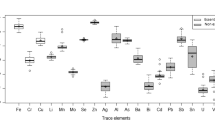Abstract
Muscle samples of Tor putitora, Neolissochilus hexagonolepis, Oncorhynchus mykiss, Schizothorax richardsonii and Cyprinus carpio were analyzed for fatty acid and amino acid composition with a view to generate nutritional information of the five important coldwater fish species of Indian upland Himalayan region. In the present study, all the fish species recorded good amounts of n-3 fatty acids (8.69–21.48 %) and the n-3/n-6 ratio ranged from 0.7 to 4.98. The amino acid score calculated based on the World Health Organization (WHO) protein standard indicated good quality proteins in the species but with mostly marginally lower values for C. carpio. However, when the amino acid levels of the fish species were compared with the recommended amino acid levels, all the fish species were found to constitute a good source of essential amino acids. Limiting amino acids such as lysine, methionine and cysteine occurred at levels higher than or marginally lower than the recommended amino acid profile. It could be concluded that the five coldwater fish species from upland Himalayan region contained high quality lipids and proteins constituting a healthy addition to the human diet.


Similar content being viewed by others

References
Food and Agricultural Organization (2006) State of world aquaculture 2006. FAO Fisheries Technical Paper No. 500. FAO, Rome. p 134
Alasalvar C, Taylor KDA, Zubcov E, Shahidi F, Alexis M (2002) Differentiation of cultured and wild seas bass (Dicentrarchus labrax): total lipid content, fatty acid and trace mineral composition. Food Chem 79:145–150
Simopoulos AP (2002) The importance of the ratio of omega-6/omega-3 essential fatty acids. Biomed Pharmacother 56:365–379
Fernandez G, Venkatrammann J (1993) Role of omega-3 fatty acids in health and disease. Nutr Res 1:19–45
Ismail HM (2005) The role of omega-3 fatty acids in cardiac protection: an overview. Front Biosci 10:1079–1088
FAO/WHO (1990) Report of the joint FAO/WHO expert consultation on protein quality evaluation. Bethesda
Chyun JH, Griminger P (1984) Improvement of nitrogen retention by arginine and glycine supplementation and its relation to collagen synthesis in traumatized mature and ageing rats. J Nutr 4:1705–1715
Saito K, Jin DH, Ogawa T, Muramoto K, Hatakeyama E, Yasuhara T (2003) Antioxidative properties of tripeptide libraries prepared by the combinatorial chemistry. J Agri Food Chem 51:3668–3674
Kim JY, Woo HJ, Ahn CW, Nam HS, Shin ZI, Lee HJ (1999) Cytotoxic effects of peptides fractionated from bromelain hydrolyzates of soybean protein. Food Sci Biotechnol 8:333–337
Ishida Y, Fujita T, Arai K (1981) New detection and separation method for amino acid by high performance liquid chromatography. J Chromatogr 204:143–148
FAO/WHO/UNU (1985) Energy and protein requirements. Report of a joint FAO/WHO/UNU Expert Consultation, World Health Organization technical report series 724. Geneva, pp 121–123
Bligh EC, Dyer WJ (1959) A rapid method of total lipid extraction and purification. Can J Biochem Physiol 37:913–917
Matcalfe LD, Schmitz AA, Pelka JR (1966) Rapid preparation of fatty acid esters from lipids for gas chromatographic analysis. Ann Chem 38:524–535
Saito H, Yamashiro R, Alasalvar C, Konno T (1999) Influence of diet on fatty acids of three subtropical fish, subfamily caseioninae (Caesio diagram and C. tile) and family siganidae (Siganus canaliculatus). Lipids 34:1073–1082
Hwang DF, Chen TY, Shiau CY, Jeng SS (2000) Seasonal variation of free amino acids and nucleotide-related compounds in the muscle of cultured Taiwanese puffer Takifugu rubripes. Fish Sci 66:1123–1129
Zhao F, Zhuang P, Song C, Shi Z, Zhang L (2010) Amino acid and fatty acid compositions and nutritional quality of muscle in the pompret, Pampus punctatissimus. Food Chem 118:224–227
Burr GO, Burr MM, Miller E (1930) On the nature and role of fatty acids essential in nutrition. J Biol Chem 86:587
Pompeia C, Freitas JS, Kim JS, Zyngier SB, Curi R (2002) Arachidonic acid cytotoxicity in leukocytes: implications of oxidative stress and eicosanoid synthesis. Biol Cell 94:251–265
Abd Rahman S, The SH, Osman H, Daud NM (1995) Fatty acid composition of some Malaysian fresh water fish. Food Chem 54:45–49
Leaf A, Webber PC (1988) Cardiovascular effects of n-3 fatty acids. New Engl J Med 318:549–555
Hearn TL, Sgoutas SA, Hearn JA, Sgoutas DS (1987) Polyunsaturated fatty acids and fat in fish flesh for selecting species for health benefits. J Food Sci 52:1209–1211
Ruiz-Capillas C, Moral A (2004) Free amino acids in muscle of Norway lobster (Nephrops norvegicus L.) in controlled and modified atmospheres during chilled storage. Food Chem 86:85–91
Christina J, Palmer A, Griffiths RD (1999) Randomized clinical outcome study of critically ill patients given glutamine-supplemented enteral nutrition. Nutr 15:108–115
Usydus Z, Szlinder-Richert J, Adamczyk M (2009) Protein quality and amino acid profiles of fish products available in Poland. Food Chem 112:139–145
Acknowledgments
Authors are grateful to Dr. BP Mohanty, Principal Scientist and Coordinator, ICAR Outreach Activity #3, CIFRI, Barrackpore for providing guidance to successfully carry out the study. They also acknowledge the Director, DCFR, Bhimtal, Nainital, Uttarakhand, India for providing facilities for the study. This study was funded under the ICAR Outreach Activity (#3) Consortium: Nutrient Profiling and Evaluation of Fish as a Dietary Component.
Author information
Authors and Affiliations
Corresponding author
Rights and permissions
About this article
Cite this article
Sarma, D., Akhtar, M.S., Das, P. et al. Nutritional Quality in Terms of Amino Acid and Fatty Acid of Five Coldwater Fish Species: Implications to Human Health. Natl. Acad. Sci. Lett. 36, 385–391 (2013). https://doi.org/10.1007/s40009-013-0151-1
Received:
Revised:
Accepted:
Published:
Issue Date:
DOI: https://doi.org/10.1007/s40009-013-0151-1



